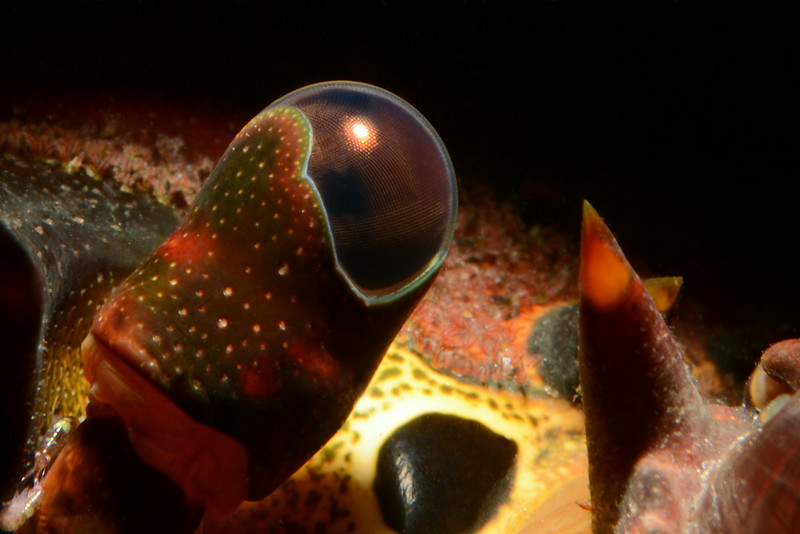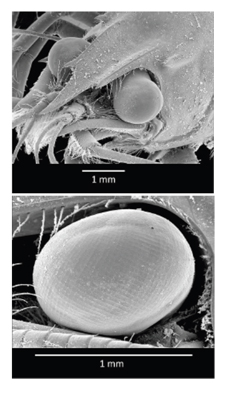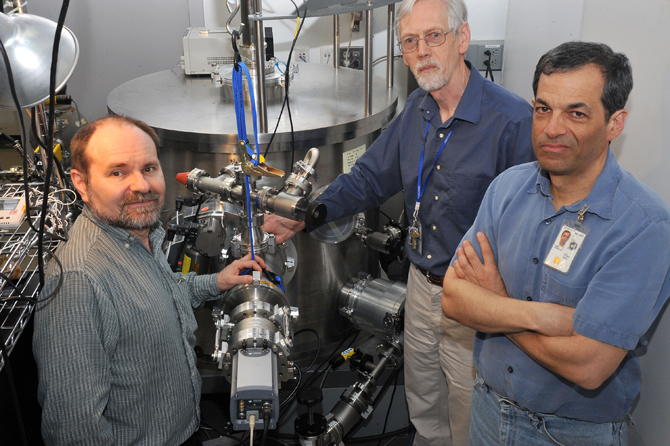Physics in the animal world: lobster and its eyes

Source: diverkevin.com
Omar, many of us perceive only as a restaurant delicacy. In fact, this is a unique animal, equipped with one of the most advanced among the crustacean visual systems. The fact is that the lobster’s eye is quite complex, it consists of small elements of an almost perfect square shape . With strong magnification, you can see the lobster's eye marking on the squares.
Representatives of the lobster familyhave large claws, otherwise their shape is similar to crayfish. True lobsters are distinguished by the presence of very large claws on the first pair of legs, and smaller ones on the second and third pairs. Males are much larger than females. The abdominal region is well developed and its segments and appendages are easily distinguishable. The body wall is represented, like all crustaceans, by two layers - the exoskeleton and ectodermal epidermis, which forms the carapace. The carapace periodically molts, allowing the animal to grow.
Lobsters are long-livers among crustaceans. Representatives of some species live up to 70 years. True, determining the age of an individual is a difficult task, but scientists use several methods at once to refine this indicator. In particular, one of the main factors is the size of the animal. The results of the study of lobsters suggest that with age they do not become less active. The ability to reproduce is also preserved. Moreover, "old men" can be more fertile than young individuals.
The larger the lobster, the more energy it needs. Food resources are limited, so the size of the animal is critical for its survival. 10-15% of lobsters die from malnutrition in adulthood. The largest lobster, according to the Guinness Book of Records, was caught in Canada. Its weight was 20.15 kg.
Another interesting fact is that lobsters have blue blood. This is a consequence of the presence of hemocyanin in it. Hemocyanin - a respiratory pigment from the group of metalloproteins, is a copper-containing functional analog of hemoglobin. It is found in the blood of mollusks, arthropods and onychophore.
Lobster Vision
 A unique visual system allows the animal to see reflected light, not refracted. Light is reflected from the mirror surface of square prisms located on the spherical surface of the eye. All these prisms are arranged in such a way that light rays reflected by some object (for example, the bottom) are focused at one point. If the eyes of the crustacean had some other shape, albeit only slightly different from the current one, the lobster would not have seen anything at all.
A unique visual system allows the animal to see reflected light, not refracted. Light is reflected from the mirror surface of square prisms located on the spherical surface of the eye. All these prisms are arranged in such a way that light rays reflected by some object (for example, the bottom) are focused at one point. If the eyes of the crustacean had some other shape, albeit only slightly different from the current one, the lobster would not have seen anything at all. Due to the fact that the lobster collects reflected light, it can also see in low light conditions. If the light is bright, then the animal's body produces a special pigment that blocks the focusing of the surface of the eye of all the rays, except those that run parallel to these prisms.
Interestingly, not all crustaceans have such a vision system, but only those who belong to the family of long-body decapod crustaceans. This family also includes shrimp lobsters. All other crustaceans use completely ordinary eyes with a light refraction system. The eyes of most other cancers consist of a large number of round or square cells. And when light enters them, it is refracted in order to focus at one point.
And what does all this give?
Scientists believe that a system whose structure will be similar to the structure of the lobster eye will allow the focus of x-rays. The fact is that concave mirrors used to focus ordinary rays are not suitable for this purpose. They are reflected only at a small angle of sliding.

NASA scientists next to the prototype Lobster Transient X-ray Detector
Such a device can be used to observe space. Roger Angel [Roger Angel] in the late 70's proposedto construct a special apparatus capable of observing the Universe in the X-ray spectrum. As a basis, he proposed taking the structure of the lobster's eye. The scientist proposed to make the surface of the lens out of small square tubes with a width of 10 to 200 microns each. The tubes themselves should consist of a special kind of glass that can reflect x-rays. Several of these lenses could be assembled into a single system for observing x-ray sources in the visible part of the Universe.

In 2012, NASA published material about its intention to create such a vehicle by placing it on board the ISS. This system is called the Lobster Transient X-ray Detector. Such a system could observe supermassive black holes, supernova explosions, neutron stars and many other objects that are of interest to modern astronomers. At the same time, the sky section available for observation in this case is quite wide.
 For the ISS, a similar tool can perform practical work - the detection of ammonia leaks. The fact is that at the station, outside, there is a large radiator in which there is anhydrous ammonia. By circulating through the pipeline, ammonia removes heat, helping to regulate the temperature on board. But as a result of a number of external factors, pipelines are sometimes damaged, microcracks arise, through which ammonia leaves. If the surface of a tank with ammonia is bombarded with electrons, experts say, you can get x-rays of a certain energy. Such a device can record the slightest changes in the integrity of the walls of the pipeline, notifying the astronauts in case of damage.
For the ISS, a similar tool can perform practical work - the detection of ammonia leaks. The fact is that at the station, outside, there is a large radiator in which there is anhydrous ammonia. By circulating through the pipeline, ammonia removes heat, helping to regulate the temperature on board. But as a result of a number of external factors, pipelines are sometimes damaged, microcracks arise, through which ammonia leaves. If the surface of a tank with ammonia is bombarded with electrons, experts say, you can get x-rays of a certain energy. Such a device can record the slightest changes in the integrity of the walls of the pipeline, notifying the astronauts in case of damage.Another use case for Lobster Eyes is the manufacture of electronic components. A conventional production system for such components is based on a photolithography process. In this case, the flux of rays through a special screen fall on the pattern of the semiconductor circuit, setting its structure. The problem is that the semiconductor pattern cannot be smaller than a certain size due to diffraction. The shorter the wavelength, the less diffraction, and the smaller the chip components can be made.
